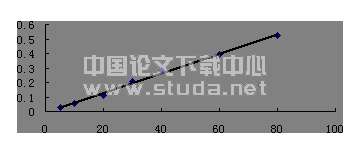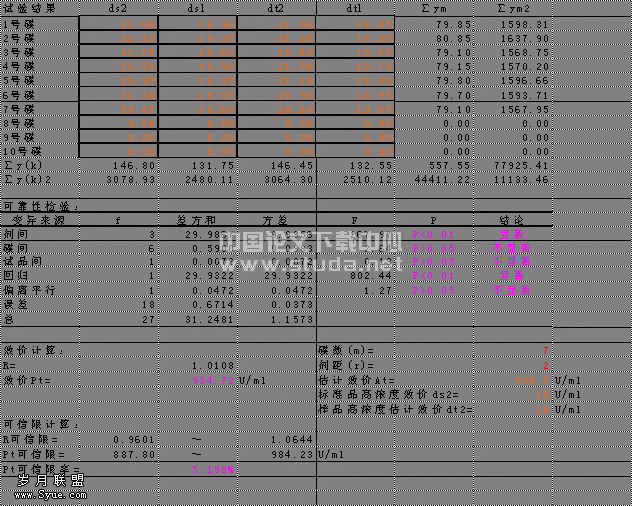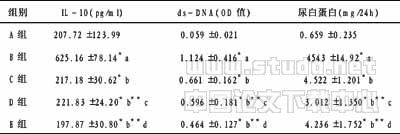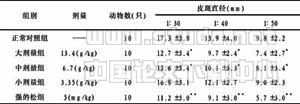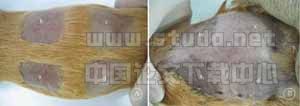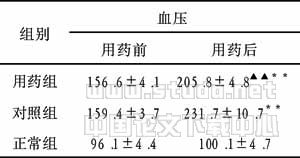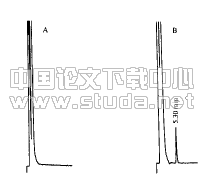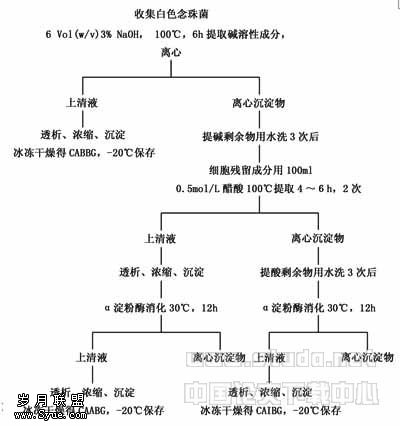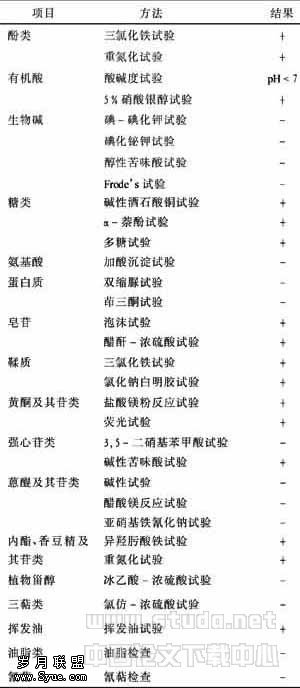明适应过程中SD大鼠视锥细胞反应的变化规律
作者:顾永昊 张作明 侯豹可 郭群 李莉 龙潭
【关键词】 视锥细胞
Properties of rat cone response during light adaptation
【Abstract】 AIM: To investigate the properties of rat cone response during light adaptation. METHODS: Thirty rats were divided into 3 groups. Their 0.5 Hz and 20 Hz cone response was recorded respectively in adapted dark and 10 s, 5, 10, 15, 20, 25 and 30 min after background light was turned on. The stimulus intensities for the three group were 1.1, 3.5 and 11.0 cd・s・m-2, respectively. RESULTS: There were some small oscillatory waves overlapped on the 0.5 Hz response bwave. For the 0.5 Hz response, with light adaptation, all three intensities' implicit time were shortened after the lighton, shortest at about 10 min, and prolonged again after then. The amplitudes also decreased after the lighton. However, with high intensity, the amplitude began to increased at about 5 min, reached an asymptotic state at 10-15 min but didn't reach the dark adapted level. For the 20 Hz response, the low intensity's implicit time delayed during light adaptation while that of the high intensity's shortened in the whole course. The low intensity's amplitude decreased after the lighton while that of high intensity' increased and reached an asymptotic state at 10-15 min, which was larger than that in dark adapted level. CONCLUSION: The stimulus frequency of 20 Hz, with the intensity of at least 3.5 cd・s・m-2 and the duration for light adaptation more than 10 minutes, is proved better in recording the rat cone response. The changes of rat cone response during the light adaptation may reflect the summary effects of rods, cones and more neuromodulatary cells.
【Keywords】 cone; light adaptation; rats
【摘要】 目的:探索明适应过程中SD大鼠视锥反应的变化. 方法:30只SD大鼠分为3组,分别在暗适应条件下、背景光打开后10 s和5,10,15,20,25及30 min,使用1.1, 3.5和11.0 cd・s・m-2的刺激光强,记录0.5 Hz及20 Hz反应. 结果:高光强时,0.5 Hz反应b波上叠加有子波. 明适应开始后,0.5 Hz反应b波的潜伏期开始缩短,在10 min左右达到最低,之后又开始延长;幅值也出现下降,低光强(1.1 cd・s・m-2)时,其幅值基本一直下降,高光强(110.0 cd・s・m-2)时,幅值很快又增加,并在10~15 min时达到最高,但一直未达到暗适应水平. 20 Hz反应,1.1 cd・s・m-2光强P1波潜伏期持续延长,3.5 cd・s・m-2光强在经历一个短暂的延长后缩短,在10 min时达到最低,随后又开始延长,110.0 cd・s・m-2光强在背景光打开后,潜伏期持续缩短,在10~15 min后达到平台期;1.1 cd・s・m-2光强P1波的幅值持续下降,3.5,110.0 cd・s・m-2光强在经历短时间下降即开始增加,特别是在110.0 cd・s・m-2光强,其幅值几乎没有下降阶段,在10~15 min达到最高,之后也进入平台期. 结论:在记录SD大鼠视锥细胞反应时,使用刺激频率为20 Hz较好,刺激光强应至少为3.5 cd・s・m-2,明适应10~15 min进行记录以保证结果的稳定性. 明适应过程中,视锥反应的变化反映了视锥、视杆细胞及更高水平神经调制细胞的综合作用.
【关键词】 视锥细胞; 明适应; 大鼠
0引言
动物的生存环境决定了其视网膜光感受器的光谱及分布特性[1]. 大鼠作为夜行性动物,视网膜中主要为视杆细胞,视锥细胞只占约1%-3%[2]. 相对于暗适应视网膜电图(scotopic electroretinogram, ScotERG),大鼠明适应视网膜电图(photopic electroretinogram, PhotERG)的幅值要低得多,且较难记录,目前多通过在刺激野中施加一定的背景光,或是闪烁反应来析出. 人明适应过程中ERG的幅值会逐渐升高,潜伏期也逐步缩短[3];小鼠也有相似的情况[4]. 我们通过给SD大鼠施加不同刺激光强,记录明适应过程中0.5 Hz及20 Hz闪烁反应随时间及光强的变化规律,为客观评价大鼠视锥细胞反应提供依据.
1材料和方法
1.1动物二级成年雄性SD大鼠30只(第四军医大学实验动物中心),约10 wk龄,体质量250~300 g,外眼及检眼镜检查无异常,随机分为3组,每组10只. 予以12 h明暗交替光照,不限食水,室温保持在22~25℃.
1.2视网膜电图记录按我实验室建立的方法对大鼠进行记录[5]. 3组大鼠分别使用1.1,3.5,11.0 cd・s・m-2的刺激光强,记录闪光频率为0.5 Hz及20 Hz的反应,各叠加3及10次. 首先在暗适应状态记录,然后在打开背景光后10 s和5,10,15,20,25及30 min时连续记录.
2结果
低光强时,0.5 Hz反应b波为单峰,当光强达到3.5 cd・s・m-2时变为双峰,光强为11.0 cd・s・m-2时成为三峰,未出现明显a波. 20 Hz反应类似正弦波,不同光强间波形无显著差别(Fig 1).
图1不同刺激光强下背景光打开后10 min所记录出的0.5 Hz及20 Hz反应的波形 (略)
明适应开始后:0.5 Hz反应b波的潜伏期开始缩短,10 min左右达到最低,之后开始延长(Fig 2A);幅值同时下降,低光强(1.1 cd・s・m-2)时,基本一直减小,高光强(11.0 cd・s・m-2)时,幅值很快又增加,在10~15 min时达到最高,但一直未达到暗适应水平(Fig 2B). 总体来看,暗适应状态时0.5 Hz反应b波潜伏期与光强成正比,幅值与光强成反比. 背景光打开后,潜伏期与光强成反比、幅值成正比,即光强越强,潜伏期越短,幅值越高.
背景光打开后,20 Hz反应1.1 cd・s・m-2光强波潜伏期持续延长,3.5 cd・s・m-2光强在一个短暂的延长后缩短,在10 min时达到最低,随后又开始延长,11.0 cd・s・m-2光强在背景光打开后,潜伏期持续缩短,在10~15 min后达到平台期(Fig 3A);1.1 cd・s・m-2光强P1波的幅值持续下降,3.5,11.0 cd・s・m-2光强在经历短时间下降即开始增加,特别是11.0 cd・s・m-2,其幅值几乎没有下降,在10~15 min达到最高(Fig 3B).
图2-图3 (略)
3讨论
低光强时,0.5 Hz组及20 Hz组的波幅值在明适应开始后一直下降,而强光刺激条件下的20 Hz组反应幅值大于暗适应时反应,与[4,6,7]的报道相似. 对于潜伏期,弱光刺激时,0.5 Hz组和20 Hz组都有一个先缩短后延长的过程;而强光刺激时,20 Hz组的潜伏期在明适应的过程中则一直在缩短,在15~20 min时达到平台期. 该结果与Daly等[8]有关背景光与视锥细胞功能的研究结果相一致.
处于暗适应状态的动物,给予光照后,会有一段时间(7~8 min)来明适应,与视紫红质的漂白有关,此时间与明适应过程中视网膜电图波幅值开始升高的时间相一致[9]. 本实验中,明适应后20 Hz组的波幅值要高于暗适应时的波幅值,而高光强20 Hz反应的幅值在明适应后一直升高,可能是由于强光对视杆细胞功能的抑制,没有出现在暗明适应转换过程中的幅值先降低后升高的过程. 因此强光时记录到的20 Hz闪烁反应可以更好地反映锥体细胞功能.
Granit等[10]认为在明适应过程中闪烁反应幅值的增加反映了视杆细胞对视锥细胞抑制的解除,一般认为是由于视紫红质的化学构象发生变化的作用[11]. 视锥细胞本身也对明适应过程中闪烁ERG波幅值的增加起着一定的作用,在离体蛙视网膜,使视杆细胞失活,在明适应过程中仍然观察到了闪烁反应幅值的增加[12]. 因此明适应过程中,闪烁反应幅值的升高应是视锥和视杆系统综合作用的结果. 鱼水平细胞[13]的研究表明在明适应过程中同时还掺杂着神经调制方面的因素.
综上所述,我们认为在记录SD大鼠视锥细胞反应时,使用的刺激频率应为20 Hz[14],刺激光强应至少为3.5 cd・s・m-2 (标准闪光),在明适应10~15 min进行记录以保持结果的稳定性. 明适应过程中,各反应的变化可能反映了视锥、视杆细胞及更高水平神经调制细胞的综合作用.
【文献】
[1] Szel A, Lukats A, Fekete T, Szepessy Z, Rohlich P. Photoreceptor distribution in the retinas of subprimate mammals [J]. J Opt Soc Am A, 2000; 17: 568-579.
[2] Szel A, Rohlich P. Two cone types of rat retina detected by antivisual pigment antibodies [J]. Exp Eye Res, 1992; 55: 47-52.
[3] Peachey NS, Alexander KR, Fishman GA, Derlacki DJ. Properties of human cone system electroretinogram during light adaptation [J]. Applied Optics, 1989; 28: 1145-1150.
[4] Peachey NS, Goto Y, AlUdaidi MR, Naash MI. Properties of mouse conemediated electroretinogram during light adaptation [J]. Neuro Lett, 1993; 162:9-11.
[5] Gu YH, Zhang ZM, Li L. Electrophysiological changes of streptoaotocininduced diabetic rats in early stage [J]. Disi Junyi Daxue Xuebao (J Fourth Mil Med Univ), 2002; 23(11): 990-993.
[6] Peachey NS, Alexander KR, Fishman GA. Visual adaptation and the cone flicker electroretinogram [J]. Invest Ophthal Vis Sci, 1991; 32(5): 1517-1522.
[7] Goto Y, Tobimatsu S, Shigematsu J, Akazawa K, Kato M. Properties of rat conemediated electroretinograms during light adaptation [J]. Current Eye Res, 1999; 19(3): 248-253.
[8] Daly SJ, Normann RA. Temporal information processing in cones: Effects of light adaptation on temporal summation and modulation [J]. Vision Res, 1985; 25: 1197-1206.
[9] Lang G, Denny N, Frumkes TE. Suppressive rodcone interactions: Evidence for separate retinal (temporal) and extrareinal (spatial) mechanisms in achromatic vision [J]. J Opt Soc Am A, 1997; 14: 2487-2498.
[10] Granit R, Riddell LA. The electrical responses of light and darkadapted frogs's eyes to rhythmic and contimuous stimuli [J]. J Physiol, 1934; 81: 1-6.
[11] Hood DC. Suppression of the frog's cone system in the dark [J]. Vision Res, 1972; 12: 889-907.
[12] Hood DC. Adaptational changes in the cone system of the isolated frog retina [J]. Vision Res, 1972; 12: 875-877.
[13] Yang XL, Wu SM. Effects of prolonged light exposure, GABA, and glycine on horizontal cell responses in tiger salamander retina [J]. J Neurophysiol, 1989; 61: 1025-1035.
[14] Hou BK, Zhang ZM, Gu YH, Li L, Guo Q. The effects of different stimulus frequency and intensity on the rat light adaptation flicker electrophysiology [J]. Disi Junyi Daxue Xuebao (J Fourth Mil Med Univ), 2003; 24(19):1780-1782
